Being able to identify your best images is one of the most important skills in photography. Wildlife and landscape photographer Darran Leal explains how he chooses his 'hero shots' – the images that lead his photo essays.
How do you go about finding and showcasing your best images? Strange as it sounds, choosing your 'hero' images is not always easy.
As photographers we can't help making emotional connections to our subjects and that can have a distorting effect on the way we see and assess our photos. Take for example a photo of a small child. While the mother or father of the child are likely to relate to the photo on a purely emotional level, other viewers are more likely to respond to factors like lighting, composition, colour, etc. That's a rather extreme example, but any photographer who has put together a portfolio, photo essay or exhibition will tell you that being able to sort your images into some sort of hierarchy, knowing 'what goes with what', and which images to leave out, is actually one of the most important and undervalued skills a photographer can have.
And it's not easy! So, how do you improve the way you go about sorting, organising and rating your images? The following tips outline my own approach, developed over 30 years as a photographer, and photography teacher. I hope you can put it to work to create compelling portfolios and photo essays of your own.
01 GET ORGANISED
For me, focusing on defining my best work is the key for organising my 'hero' images as quickly as possible. I sort my images from a day's shoot each evening, while I have the excitement of the experience in my mind. Downloading and sorting usually takes me about 20 to 30 minutes, no more. I don't shoot large numbers of images – generally around 50 to 300 in any full day in the field. However, another photographer beside me might shoot double that amount, or even triple! It's a very personal choice in our exploration of this creative art form.
Importantly, before downloading and sorting, I have started to define images for quality as I shoot. I memorise the opportunities that I think could offer a unique result. As an example, in Morocco last November, halfway through our tour, we started one day with a sunrise over the Sahara Desert, then we shot a traditional Bedouin camp and its people, then we saw some amazing fossils, and we finished that day with a shoot at an ancient adobe village. It was a diverse series of subjects in one day, but I can still remember the stand-out shooting opportunities – the images that stood out for me, as distinct from being mere snapshots. I'm not hung up on technicalities. I'm more concerned about whether an image is eye catching, or if it has a particular use in a project I'm doing. While technical correctness can be important to help you pick your best image, how important is creativity? Does the image need to be sharp? Does a landscape need to work in thirds? What about that leading line? They can be important points for defining your best work in some images and in other images, perhaps not.
Remember, the most important point is that you like it. I rarely bother thinking about whether others will like a particular shot. But I will consider some images for specific jobs. This could be for use in a particular magazine. I rarely enter photo competitions, but if I do, I make sure that any such images are clearly marked in my filing system and easy to find.
This flows on to downloading and it finishes with sorting and rating my images in the field. When I'm on a tour I download my images into one folder per tour, or country, each day. This year I have created a King Island folder for our tour there. I am also visiting Guatemala and Cuba so I am creating a folder for each country. The images are in date order, organised by simply dropping them into the folder, so it's easy to manually backtrack through and find something if it's required.
I use Adobe Lightroom for my post-production work, to import the images and to undertake sorting. One key for me is that I have a strong memory of the day's best images, fresh in my mind, so I can rate these images using this starting point.
Sometimes it's not until you look at the results on large screen that you'll see a photo's true impact. I start with a 'one star' rating, which in my system means that I think they're great images, but they are not yet processed. I move through the images and rate them as I go. Later, I will process the image and once it's finished, I will give it a rating out of five stars. This tells me it's ready to send to an editor, add in a book, or use in some other option. Lots of variations to marking images are available in different programs. Use the one that suits you best, but my big tip here is 'KIS', or 'Keep It Simple'. Who wants to be working on a laptop for hours in the field when you could be shooting, or simply enjoying a stunning location? 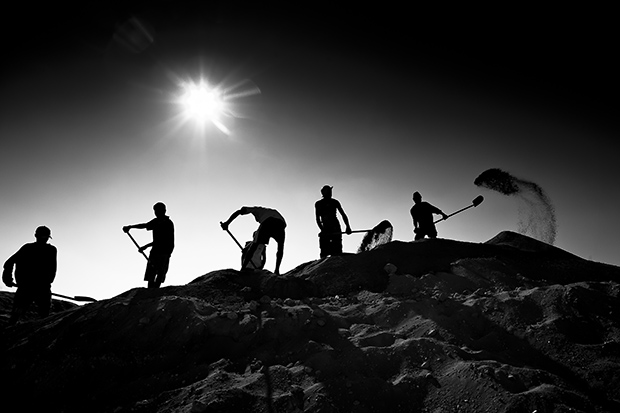
Sapphire hunters working hard in Madagascar. For me, black and white offered far more drama to this image. Canon 5D, 24-105mm lens @ 24mm, 1/1500s @ f/8, ISO 200, hand held. B&W conversion, contrast, blacks, sharpened. Adjusted in Adobe Lightroom 5.
02 REDEFINE YOUR BEST
At the end of an adventure, especially if I'm sitting in an airport, I'll go through my images for a second time. I work on the basis that I'm looking at them with fresh eyes, because I've had a break from my initial sorting. I confirm my best work, but I will go through this time looking specifically for images which might have another use. Images which will work in black and white don't always show themselves straight away. What you think is a 'hero' image might not interest a magazine editor. What you think will work well in a photo competition, might not. The photographers who are best at selecting their 'hero' images will often understand the needs of a target use. This can require the selection of an image (or images) they might not always personally select. You might also consider creating a 'Collection' in Lightroom, targeting specific topics like landscapes, people, birds or for a special project like a book. I don't do this, but some of my customers love to use this system to find their own 'hero' images.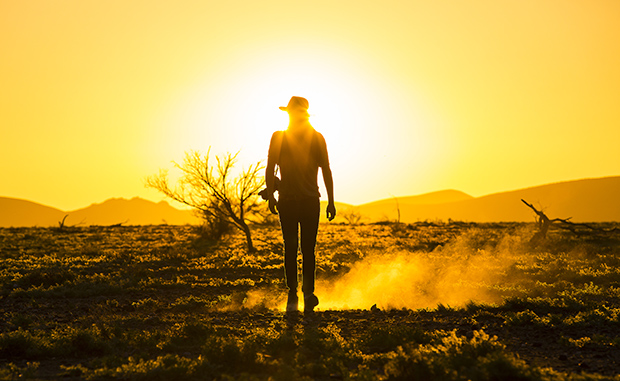
The Flinders Ranges offers great landscapes and iconic outback shoots. This shot is an iconic Aussie outback image. Canon 5D Mk III, 70-200mm lens @ 200mm, 1/750s @ f/8, ISO 400, hand held. Vibrance, contrast, shadows, sharpened. Adjusted in Adobe
Lightroom 5.
03 SOFTWARE SOLUTIONS
Photographers need to be organised and disciplined, especially in today's digital era. For example, if you don't understand a good base software program to help you sort out and edit your images, and you don't keep your images in a logical order, if you don't archive (and back up) your digital files, then any of these points can negatively impact on your craft. You don't want to be 'a clone' and some of us will perform our best creative work in a more organic way. But try to balance being pedantic with being creative. Staying on top of your catalogue and understanding the basics of your key programs is an important skill in the digital world and it will have a long-term benefit in your quest to refine your best images.
04 FIND YOUR DIRECTION
Understanding the direction in which you wish to take your photography is vital. I consider this a key starting point whether you're shooting or putting together a portfolio. It doesn't matter whether you're a novice or a seasoned shooter, having a direction will not only guide what and how you shoot, but how you present your work.
You might have great images, but without a clear aim or theme it can be a battle to reach your creative goals. Your ambition could be anything from simply taking images for your own satisfaction, to sharing them with the world. Before you begin a project, think carefully about what you're doing, what you're trying to achieve and the story you want to tell.
05 TAKE ON A PROJECT
On a similar tack, whether you're shooting at home or travelling the world set projects and goals for yourself. For a beginner photographer your goal might be as simple as making a series of portraits with the eyes in focus and the background blurred by a restricted depth of field. For a more advanced photographer you might set yourself the goal of photographing a particular bird species in your area with the aim of creating a custom photo book. Thinking about how the images will be used later on can be a great way to get you thinking creatively as you have to approach the same subject from a range of different perspectives. Rather than just taking photographs for the fun of it set yourself a project – with a deadline – and finish it. No matter how experienced you are, I guarantee you will learn new things with each new challenge.
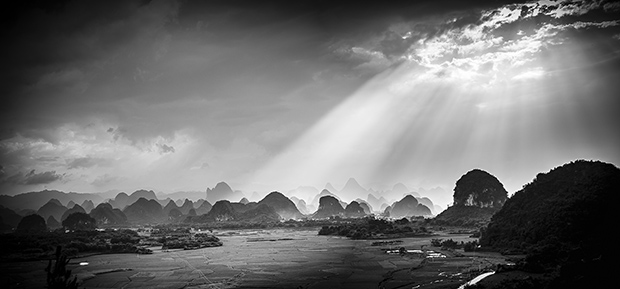
China has some of the most amazing landscapes on the planet. This scene was very hot and humid, offering us special atmospheric conditions. Canon 5D Mk III, 24-70mm lens @ 50mm, 1/180s @ f/11, ISO 200. Multi-shot panorama, hand held. B&W conversion, contrast, blacks, sharpened. Adjusted in Adobe Lightroom 5, stitched together in Photoshop.
06 WORKFLOW AND BACKUP
I transfer the images from my laptop and archive them to my Drobo 15TB data storage system, which is linked to my desktop system. This is very important! You should have at least two copies of your images – always! Drives and storage devices can crash, with terrible consequences if you don't have a copy. This is even more important for your 'hero' shots. When you're in a less exciting or distracting location, you should be able to go through all your images and enjoy them again. This is a handy time for sorting those last few images to add to your 'hero' list. I shoot in RAW and I convert my images to DNG (Digital Negative files) as they import. This keeps any processing, or image rating information with the photo and it's simple.
Some of you might be thinking that I do a lot of sorting of my images. Nothing could be further from the truth! I spend as little time as possible with each step. Likewise, I spend as little time as possible with image processing. As a general rule (and obviously subject to the rare times when complex creative Photoshop is required) I spend less than a minute on most of my images in post-production processing. So, from 3,000 images from a two-week tour I might end up with around 300 'hero' images, rated as five-star book quality. I don't process every image.
A special moment as a new-born pup bonds with mum on the Galapagos Islands in 2005. Canon EOS 5D, 100-400mm lens @ 150mm, 1/350s @ f/5.6, ISO 200, hand held. Vibrance, contrast, shadows, sharpened. Adjusted in Adobe Lightroom 5.
07 MAKE A BOOK
The arrival of affordable limited-run photo book printing has been a boon for amateur and professional photographers alike. There are a number of options available and it's possible to produce a glossy coffee-table book showcasing your own images in just a few days.
This is where your skill at sorting your images and working out which images work well together comes to the fore. Think about visual style and the story that your pictures tell. Experiment with different layouts and keep asking yourself, does this image advance the story I am telling or detract from it. Sometimes you might find a great image actually takes away from what you are trying to achieve. It might jar with the visual style of the other images, or act as a distraction from the message you are tring to convey. Sometimes you need to be ruthless – if it's not helping, get rid of it.
Practically, you'll find it helps if your photo library is well organised. When I put together a book of a recent photo tour, I go to the folder in Lightroom and sort the images so only those images with five-star ratings are shown. As long as you rate your images as you go, this step can be a big time saver.
I shot this image while on tour in the Canadian Rockies in 2007. The year is not so important to me. Finding it fast is! Canon EOS 5D, 17-40mm lens @ 17mm, 41s @ f/16, ISO 100, tripod. Vibrance, contrast, shadows, sharpened. Adjusted in Adobe Lightroom 5.
08 SHARE YOUR AMAZINGNESS!
On most of my travels, by the time I start organising photo books I have uploaded my images to Facebook and Instagram during the trip. Most of these would be straight 'fun' travel pics, with what I reckon is the odd 'cool' shot. Once I get home I will start to upload some of the more creative images.
I also love audio-visuals. Since 1982 I have set a selection of 'hero' images to music. It's a fantastic way to show friends and family what's happened, and for me, it opens up business opportunities. Your phone is another top tool for showing images. I have 'hero' images on my phone and I can easily show anyone who's interested in a cross-section of my work. 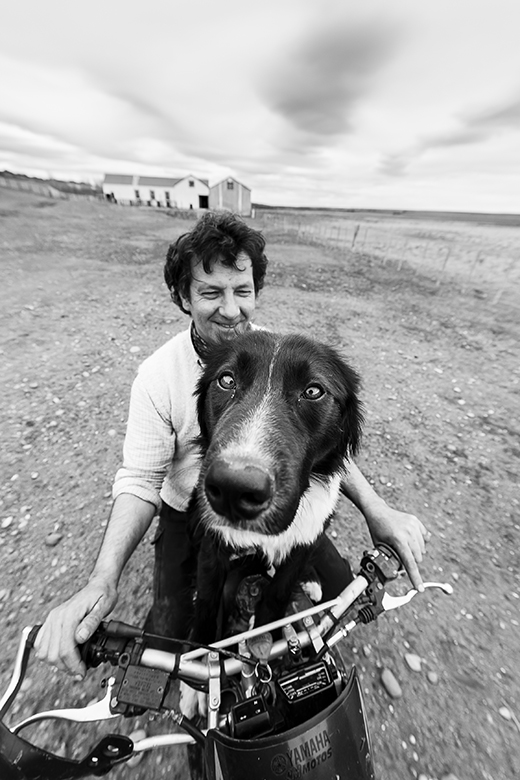
Working dogs are a key to a farmer's success all over the world. This image was shot in Patagonia, using a super wide-angle lens, up close. Nikon D3X, 14-24mm lens @ 14mm, 1/750s @ f/5.6, ISO 400, EV +1, hand held. B&W conversion, contrast, blacks, sharpened. Adjusted in Adobe Lightroom 5.
09 CREATE A HERO FOLDER
For me, a 'hero' folder is very important. At all times I have my 'hero' images with me as processed RAW files. I have the same folder on my laptop in the field and on my desktop in the office. Many times each year, when I'm on tour and writing articles for AP I can go straight to my 'hero' folder and access images to suit a given theme.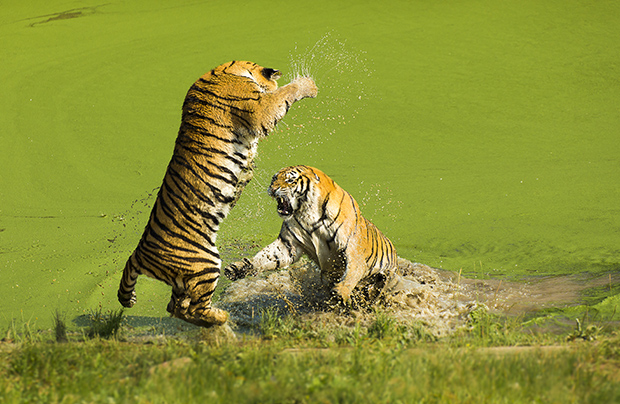
Finding rare animals easily in your filing system can be important when you're organising special projects. These Siberian Tigers are images I might not ever get to shoot again. Canon 5D Mk III, 50-500mm lens @ 244mm, 1/1500s @ f/5.6, ISO 400, hand held. Vibrance, contrast, shadows, sharpened. Adjusted in Adobe Lightroom 5.
10 THE NEXT STEP
If you've followed this advice on organising your files, you should now have your best images separated into a hero folder. Now it's time to share your images with the world. Here's a couple of ideas for you. Contact a magazine (you can get the editor of this mag at editor@australianphotography.com) or your local newspaper with a story submission. Enter a portfolio competition like AP's 2015 Photographer of the Year (www.australianphotography.com). Or, if that all sounds too hard, try putting together your own photo book? I love the fact that anyone, of any experience level, can so easily share their work in print. 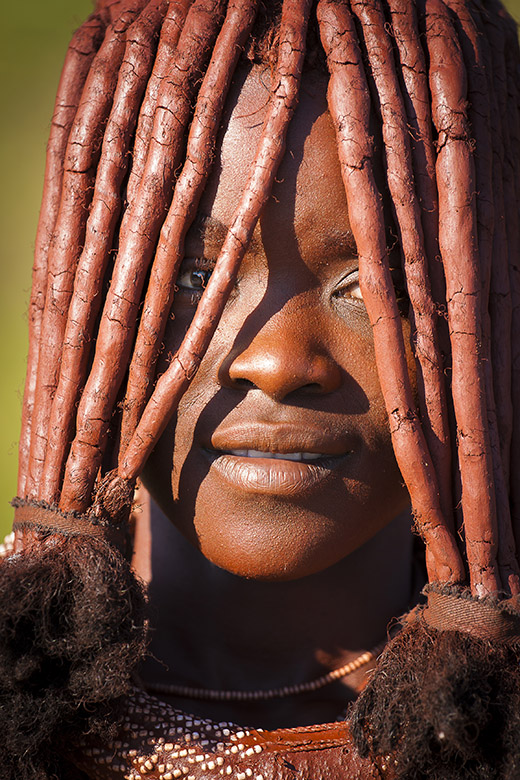
Visiting the Himba people offers great oppotunities to photograph the local culture. Sony A900, 70-400mm lens @ 300mm, 1/200s @ f/5.6, ISO 100, hand held. Adjusted vibrance, contrast, shadows, sharpness in Lightroom 5.
TOP TIPS FOR SHOOTING 'HERO' SHOTS
1. Isolate your subject, either by using limited depth of field or by positioning the subject. This approach draws the viewer straight to the subject and limits distractions.
2. A balanced look between strictly correct technical elements and a creative feel is vital to the final result. You can be as technical as you like, but in my view the best images come from a balanced look.
3. Give yourself space for the subject within the frame. Especially with cameras which can shoot huge files, you can always crop to suit your creative thinking.
4. Visualisation of the end result is vital. This includes visualisation pre-shooting, while shooting, and in post production. Not only do you need to take the shoot itself into consideration, you also need to think about how you'll process the image. Photography is not just about pressing the shutter button!










